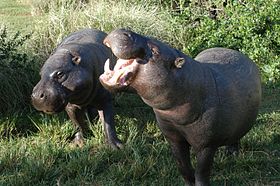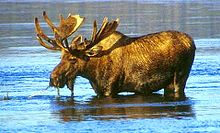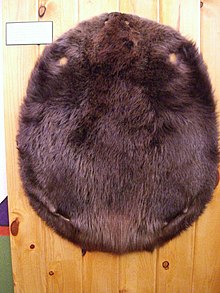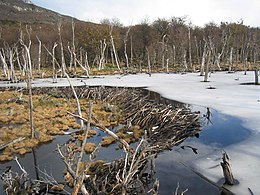Aquatic mammal
Aquatic and semiaquatic mammals are a diverse group of
Mammal adaptation to an aquatic lifestyle vary considerably between species. River dolphins and manatees are both fully aquatic and therefore are completely tethered to a life in the water. Seals are semiaquatic; they spend the majority of their time in the water, but need to return to land for important activities such as mating, breeding and molting. In contrast, many other aquatic mammals, such as hippopotamus, capybara, and water shrews, are much less adapted to aquatic living. Likewise, their diet ranges considerably as well, anywhere from aquatic plants and leaves to small fish and crustaceans. They play major roles in maintaining aquatic ecosystems, beavers especially.
Aquatic mammals were the target for commercial industry, leading to a sharp decline in all populations of exploited species, such as beavers. Their pelts, suited for conserving heat, were taken during the
Taxonomy and evolution
Groups
- This list covers only mammals that live in freshwater. For a list of saltwater mammals, see Marine mammal.
- Order Sirenia: sirenians
- Family Trichechidae: manatees
- Amazonian manatee (Trichechus inunguis)
- African manatee (Trichechus senegalensis)
- Family Trichechidae: manatees
- Order Cetartiodactyla: even-toed ungulates
- Suborder Whippomorpha
- Family Platanistidae
- Ganges river dolphin, or susu (Platanista gangetica)
- Indus river dolphin, or bhulan (Platanista minor)
- Family Iniidae
- Amazon river dolphin, or boto (Inia geoffrensis)
- Araguaian river dolphin (Inia araguaiaensis)
- Family Lipotidae
- Chinese river dolphin, or baiji (Lipotes vexillifer) possibly extinct
- Family Pontoporiidae
- La Plata dolphin, or franciscana (Pontoporia blainvillei)
- Family Hippopotamidae: hippopotamuses
- Hippopotamus (Hippopotamus amphibius)
- Pygmy hippopotamus (Choeropsis liberiensis)
- Family Platanistidae
- Suborder Whippomorpha
- Order Carnivora
- Family Mustelidae
- Subfamily Lutrinae
- Eurasian otter (Lutra lutra)
- Hairy-nosed otter (Lutra sumatrana)
- Spotted-necked otter (Hydrictis maculicollis)
- Smooth-coated otter (Lutrogale perspicillata)
- North American river otter (Lontra canadensis)
- Southern river otter (Lontra provocax)
- Neotropical river otter(Lontra longicaudis)
- Giant otter (Pteronura brasiliensis)
- African clawless otter (Aonyx capensis)
- Oriental small-clawed otter(Aonyx cinerea)
- Subfamily Mustelinae
- European mink (Mustela lutreola)
- American mink (Neogale vison)
- Subfamily
- Family Phocidae
- Genus Pusa
- Baikal seal (Pusa sibirica)
- Ladoga seal(Pusa hispida ladogensis)
- Saimaa seal(Pusa hispida saimensis)
- Genus Pusa
- Family Mustelidae
- Order Rodentia: rodents
- Suborder Hystricomorpha
- Capybara (Hydrochoerus hydrochaeris)
- Lesser capybara (Hydrochoerus isthmius)
- Coypu(Myocastor coypus)
- Family Castoridae: beavers
- North American beaver (Castor canadensis)
- Eurasian beaver (Castor fiber)
- Family Cricetidae
- Muskrat (Ondatra zibethicus)
- European water vole (Arvicola amphibius)
- Suborder Hystricomorpha
- Monotremata: monotremes
- Platypus (Ornithorhynchus anatinus)
- Order Afrosoricida
- Giant otter shrew (Potamogale velox)
- Order Eulipotyphla
- Family Soricidae: shrews
- Malayan water shrew (Chimarrogale hantu)
- Himalayan water shrew (Chimarrogale himalayica)
- Sunda water shrew(Chimarrogale phaeura)
- Japanese water shrew (Chimarrogale platycephala)
- Chinese water shrew (Chimarrogale styani)
- Sumatran water shrew (Chimarrogale sumatrana)
- Elegant water shrew (Nectogale elegans)
- Mediterranean water shrew (Neomys anomalus)
- Eurasian water shrew (Neomoys fodiens)
- Transcaucasian water shrew (Neomys teres)
- Glacier Bay water shrew (Sorex alaskanus)
- American water shrew (Sorex palustris)
- Pacific water shrew, or marsh shrew (Sorex bendirii)
- Family Talpidae (moles and relatives)
- Russian desman (Desmana moschata)
- Family
- Order Didelphimorphia: opossums
- Family Didelphidae: opossums
- Big lutrine opossum (Lutreolina crassicaudata)
- Massoia's lutrine opossum (Lutreolina massoia)
- Yapok(Chironectes minimus)
- Family
Evolution
Mesozoic
One of the first known proto-mammals similar to modern placentals was aquatic, the
Another docodontan, the Late Jurassic Haldanodon, has been suggested to be a platypus or desman-like swimmer and burrower, being well adapted to dig and swim and occurring in a wetland environment.[2]
The
Another lineage of Mesozoic mammals, the
However, two other eutriconodonts, Dyskritodon and Ichthyoconodon, occur in marine deposits with virtually no dental erosion, implying that they died in situ and are thus truly aquatic mammals.[6] Nonetheless, Ichthyoconodon may not be aquatic, but instead a gliding mammal.[7][8] More recently, Yanoconodon and Liaoconodon have been interpreted as semiaquatic, bearing a long body and paddle-like limbs.[9]
A
Cenozoic
An extinct genus,
The most popular theory of the origins of Hippopotamidae suggests that hippos and whales shared a

Sirenians, along with
The oldest fossil of the modern platypus dates back to about 100,000 years ago, during the
Marine mammals
Marine mammals are aquatic mammals that rely on the ocean for their existence. They include animals such as sea lions, whales, dugongs, sea otters and polar bears. Like other aquatic mammals, they do not represent a biological grouping.[26]

Marine mammal adaptation to an aquatic lifestyle vary considerably between species. Both
Marine mammals were first hunted by aboriginal peoples
Adaptations
Mammals evolved on land, so all aquatic and semiaquatic mammals have brought many terrestrial adaptations into the waters. They do not breathe underwater as fish do, so their respiratory systems had to protect the body from the surrounding water;
Aquatic mammals also display a variety of locomotion styles. Cetaceans excel in streamlined body shape and the up-and-down movements of their flukes make them fast swimmers; the tucuxi, for example, can reach speeds of 14 miles per hour (23 km/h).[46] The considerably slower sirenians can also propel themselves with their fluke, but they can also walk on the bottom with their forelimbs.[47] The earless seals (Phocidae) swim by moving their hind-flippers and lower body from side to side, while their fore-flippers are mainly used for steering.[27] They are clumsy on land, and move on land by lunging, bouncing and wiggling while their fore-flippers keep them balanced;[29] when confronted with predators, they retreat to the water as freshwater phocids have no aquatic predators.[48]

Some aquatic mammals have retained four weight-bearing limbs (e.g. hippopotamuses, beavers, otters, muskrats) and can walk on land like fully terrestrial mammals. The long and thin legs of a moose limit exposure to and friction from water in contrast to hippopotamuses who keep most of their body submerged and have short and thick legs. The semiaquatic pygmy hippopotamus can walk quickly on a muddy underwater surface thanks to robust muscles and because all toes are weight-bearing. Some aquatic mammals with flippers (e.g. seals) are amphibious and regularly leave the water, sometimes for extended periods, and maneuver on land by undulating their bodies to move on land, similar to the up-and-down body motion used underwater by fully aquatic mammals (e.g. dolphins and manatees).[27]
Beavers, muskrats, otters, and capybara have fur, one of the defining mammalian features, that is long, oily, and waterproof in order to trap air to provide insulation.
Wading and bottom-feeding animals (e.g. moose and manatee) need to be heavier than water in order to keep contact with the floor or to stay submerged, surface-living animals (e.g. otters) need the opposite, and free-swimming animals living in open waters (e.g. dolphins) need to be neutrally buoyant in order to be able to swim up and down the water column. Typically, thick and dense bone is found in bottom feeders and low bone density is associated with mammals living in deep water.[27]
The shape and function of the eyes in aquatic animals are dependent on water depth and light exposure: limited light exposure results in a retina similar to that of nocturnal terrestrial mammals. Additionally, cetaceans have two areas of high ganglion cell concentration ("best-vision areas"), where other aquatic mammals (e.g. seals, manatees, otters) only have one.[27]
Among non-placental mammals, which cannot give birth to fully developed young,
Ecology
Keystone species

Beaver ponds have a profound effect on the surrounding ecosystem. Their first and foremost ecological function is as a reservoir for times of drought, and prevent drying of riverbeds. In the event of a flood, beaver ponds slow down water-flow which reduces erosion on the surrounding soil.[51] Beaver dams hold sediment, which reduces turbidity and thereby improving overall water quality downstream. This supplies other animals with cleaner drinking water and prevents degradation of spawning grounds for fish.[52][53] However, the slower water speed and lack of shade from trees (that have since been cut down to construct the dam), results in the overall temperature increasing.[51] They also house predatory zooplankton which help break down detritus and control algae populations.[52]
Diet
Beavers are herbivores, and prefer the wood of
Indian rhinoceros are grazers. Their diets consist almost entirely of grasses, but they also eat leaves, branches of shrubs and trees, fruits, and submerged and floating aquatic plants. They feed in the mornings and evenings. They use their prehensile lips to grasp grass stems, bend the stem down, bite off the top, and then eat the grass. They tackle very tall grasses or saplings by walking over the plant, with legs on both sides and using the weight of their bodies to push the end of the plant down to the level of the mouth.[57]
Manatees make seasonal movements synchronized with the flood regime of the Amazon Basin. They are found in flooded forests and meadows during the flood season when food is abundant, and move to deep lakes during the dry season.[58] The Amazonian manatee has the smallest degree of rostral deflection (25° to 41°) among sirenians, an adaptation to feed closer to the water surface.[59]
A moose's diet often depends on its location, but they seem to prefer the new growths from

Hippopotamuses leave the water at dusk and travel inland, sometimes up to 10 km (6 mi),
The
Generally, all aquatic
Interactions with humans
Exploitation

Fur robes were blankets of sewn-together, native-tanned, beaver pelts. The pelts were called castor gras in French and "coat beaver" in English, and were soon recognized by the newly developed felt-hat making industry as particularly useful for felting. Some historians, seeking to explain the term castor gras, have assumed that coat beaver was rich in human oils from having been worn so long (much of the top-hair was worn away through usage, exposing the valuable under-wool), and that this is what made it attractive to
Otters have been hunted for their pelts since at least the 1700s. There has been a long history of otter pelts being worn around the world. In China it was standard for the royalty to wear robes made from them. People that were financially high in status also wore them.
Habitat degradation
One problem at Lake Baikal is the introduction of pollutants into the ecosystem. Pesticides such as DDT and hexachlorocyclohexane, as well as industrial waste, mainly from the Baykalsk Pulp and Paper Mill, are thought to have been the cause of several disease epidemics among Baikal seal populations.[86] The chemicals are speculated to concentrate up the food chain and weaken the Baikal seal's immune system, making them susceptible to diseases such as canine distemper and the plague, which was the cause of a serious Baikal seal epidemic that resulted in the deaths of thousands of animals in 1997 and 1999. Baikal seal pups have higher levels of DDT and PCB than known in any other population of European or Arctic earless seal.[86]
In the 1940s, beavers were brought from Canada to the island of
In some European countries, such as Belgium, France, and the Netherlands, the muskrat is considered an invasive pest, as its burrowing damages the dikes and levees on which these low-lying countries depend for protection from flooding. In those countries, it is trapped, poisoned, and hunted to attempt to keep the population down. Muskrats also eat corn and other farm and garden crops growing near water bodies.[88]

Urban and agricultural development, increased damming, and increased use of hydroelectric power in rivers in countries such as Côte d'Ivoire and Ghana are threats to the African manatee's habitat and life, and thick congestion of boats in waterways may cause them to have a deadly run-in with the vessels. However, even natural occurrences, such as droughts and tidal changes, often strand manatees in an unsuitable habitat. Some are killed accidentally by fishing trawls and nets intended for catching sharks.[89] The Amazonian manatee is at risk from pollution, accidental drowning in commercial fishing nets, and the degradation of vegetation by soil erosion resulting from deforestation.[58] Additionally, the indiscriminate release of mercury in mining activities threatens the entire aquatic ecosystem of the Amazon Basin.[58]
As China developed economically, pressure on the
As food
Moose are hunted as a
...like tender beef, with perhaps more flavour; sometimes like veal”
— Henry David Thoreau of The Maine Woods describing the taste of moose meat
In the 17th century, based on a question raised by the Bishop of Quebec, the Roman Catholic Church ruled that the beaver was a fish (beaver flesh was a part of the indigenous peoples' diet, prior to the Europeans' arrival[97]) for purposes of dietary law. Therefore, the general prohibition on the consumption of meat on Fridays did not apply to beaver meat.[97] This is similar to the Church's classification of other semiaquatic rodents, such as the capybara and muskrat.[98][99]
See also
References
- S2CID 46067702.
- ^ Thomas Martin, Postcranial anatomy of Haldanodon exspectatus (Mammalia, Docodonta) from the Late Jurassic (Kimmeridgian) of Portugal and its bearing for mammalian evolution, Forschungsinstitut Senckenberg, Senckenberganlage 25, 60325 Frankfurt am Main, Germany Received October 2004; accepted for publication March 2005
- ^ Anusuya Chinsamy-Turan, Forerunners of Mammals: Radiation • Histology • Biology, Indiana University Press, 18/11/2011
- ^ Bob H. Slaughter, Astroconodon, the Cretaceous Triconodont, Journal of Mammalogy, Vol. 50, No. 1 (Feb., 1969), pp. 102-107
- ISBN 0-231-11918-6.
- ^ Sigogneau-Russell, Denise (1995). "Two possibly aquatic triconodont mammals from the Early Cretaceous of Morocco" (PDF). Acta Palaeontologica Polonica. 40 (2): 149–162.
- .
- S2CID 85069761.
- ^ Meng Chen, Gregory Philip Wilson, A multivariate approach to infer locomotor modes in Mesozoic mammals, Article in Paleobiology 41(02) · February 2015
- ISBN 978-0-231-50927-5.
- ^ .
- ^ Foster-Turley, Pat; Macdonald, Sheila; Mason, Chris, eds. (1990). "Otters: An Action Plan for their Conservation". IUCN/SSC Otter Specialist Group: Sections 2 and 12.
- PMID 9159931.
- ^ PMID 25710445.
- PMID 9881471.
- PMID 15677331.
- PMID 11027333.
- PMID 11296868.
- PMID 24465386.
- PMID 17244368.
- PMID 17516441.
- S2CID 4346804.
- S2CID 89034974.
- PMID 19805098.
- ^ Folger, Tim (1993). "A platypus in Patagonia (Ancient life - 1992)". Discover. 14 (1): 66.
- OCLC 326418543.
- ^ PMID 17516440.
- .
- ^ OCLC 19511610.
- .
- S2CID 8925215.
- OCLC 757032303.
- ^ "WWF Endangered Marine Species Guide September 2019" (PDF). worldwildlife.org. Retrieved 11 June 2023.
- S2CID 45416687.
- OCLC 42467530.
- PMID 17148336.
- doi:10.1644/747.
- ^ Clifford, Frank (1994). "Gray Whale Removed From Endangered List". Los Angeles Times. Retrieved 27 January 2016.
- ^ a b Haw, Jim; Handy, Dana (2013). "Northern Elephant Seals: Increasing Population, Decreasing Biodiversity". Scientific American. Retrieved 28 June 2016.
- . Retrieved 19 December 2023.
- .
- .
- JSTOR 1383602.
- .
- .
- ^ Edwards, Holly H.; Schnell, Gary D. (2001). "Body Length, Swimming Speed, Dive Duration, and Coloration of the Dolphin Sotalia fluviatilis (Tucuxi) in Nicaragua" (PDF). Caribbean Journal of Science. 37: 271–298.
- OCLC 822025146.
- ^ Perrin 2009, p. 924.
- OCLC 437346699.
- ^ Michael L. Power,Jay Schulkin. The Evolution Of The Human Placenta. pp. 68–.
- ^ hdl:11250/2438080.
- ^ S2CID 39775996.
- ^ "Turbidity: Description, Impact on Water Quality, Sources, Measures" (PDF). Minnesota Pollution Control Agency. March 2008. Retrieved 16 June 2016.
- ^ Ringelman, James K. "Managing Beaver to Benefit Waterfowl" (PDF). USGS.gov. United States Geological Survey. Retrieved 2 April 2015.
- OCLC 905649783.
- JSTOR 2425316.
- S2CID 253915386. Archived from the original(PDF) on 29 June 2017. Retrieved 23 June 2016.
- ^ . Retrieved 11 November 2021.
- doi:10.1578/AM.40.2.2014.139. Archived from the original(PDF) on 17 September 2016. Retrieved 26 June 2016.
- ^ Howard, Janet L. (1996). "Populus tremuloides". U.S. Department of Agriculture, Forest Service, Rocky Mountain Research Station, Fire Sciences Laboratory. Retrieved 14 June 2016.
- OCLC 607394660.
- OCLC 1054473.
- ISBN 978-0809439195.
- OCLC 37713037.
- OCLC 19554262.
- ^ "Hippopotamus". Kruger National Park. Retrieved 18 June 2007.
- S2CID 216152807.
- OCLC 42274422.
- .
- OCLC 300296060.
- ^ "Ganges River dolphin". World Wildlife Fund. Retrieved 26 June 2016.
- . Retrieved 11 November 2021.
- ISSN 0034-7744.
- ^ "Water voles get a taste for frogs". BBC News. 30 April 2010. Retrieved 13 June 2016.
- OCLC 449865266.
- OCLC 123137094.
- ISBN 978-1-276-66898-9.
- ^ . Retrieved 19 December 2023.
- S2CID 253915386. Archived from the original(PDF) on 29 June 2017. Retrieved 23 June 2016.
- ^ Menon, Vivek (1996). "Under siege: Poaching and protection of Greater One-horned Rhinoceroses in India" (PDF). TRAFFIC India. Retrieved 26 June 2016.[permanent dead link]
- OCLC 36838946.
- ^ Adhikari, T. R. (2002). "The Curse of Success" (PDF). Habitat Himalaya – A Resources Himalaya Factfile. Retrieved 26 June 2016.
- ^ Ingrams, F. C. (1924). "Furs and the Fur Trade". Journal of the Royal Society of Arts. 72 (3739): 593–605.
- ^ "Breed history". The Otterhound Club of America. Archived from the original on 15 August 2016. Retrieved 26 June 2016.
- ^ "Otters feel the heat in Southeast Asia". TRAFFIC. 2009. Retrieved 26 June 2016.
- ^ PMID 15296299.
- ^ Loewy, Matías (2015). "North American Beaver Invasion Occupies Forests and Steppes in Southern Chile and Argentina". Scientific American. Retrieved 25 June 2016.
- .
- . Retrieved 19 December 2023.
- ^ Klinowska, Margaret; Cooke, Justin (1991). Dolphins, Porpoises, and Whales of the World: the IUCN Red Data Book (PDF). pp. 41–46.
- ^ Black, Richard (27 June 2006). "Last Chance for China's Dolphin". Archived from the original on 6 July 2006. Retrieved 27 June 2006.
- ^ "Rescue Plan Prepared for Yangtze River Dolphins". 11 July 2002. Retrieved 18 December 2006.
- PMID 17686754.
- ^ "Moose, meat, raw (Alaska Native)". Self Nutrition Data. Retrieved 25 June 2016.
- ^ "All-clear for Finnish foods". Food Quality News. 2003. Retrieved 25 June 2016.
- S2CID 28322519.
- ^ OCLC 678751406.
- ^ "In Days Before Easter, Venezuelans Tuck Into Rodent-Related Delicacy". The New York Sun. 24 March 2005. Archived from the original on 25 February 2010. Retrieved 15 March 2010.
- ^ Holusha, John (April 1988). "Where the Muskrat Is a Delicacy for Lent". The New York Times. Retrieved 18 June 2016.
Further reading
- Perrin, W. F.; Wursig, B.; Thewissen, J. G. M. (2009). Encyclopedia of Marine Mammals. San Diego: Academic Press. ISBN 978-0-0809-1993-5.


